The Impact of Digital Technologies on Business and Customer Experience
VerifiedAdded on 2023/06/11
|9
|2741
|353
Report
AI Summary
This report explores the impact of digital technologies on business, management structures, and customer experience. It highlights the importance of customer experience in the digital age, discussing technologies like customer data management, cloud solutions, AI, and omnichannel approaches. The report links these technologies to business management theories such as Classical Management Theory, Systems Theory of Management, and the Contingency Approach, illustrating how technology enhances productivity, communication, and adaptability within organizations. It concludes that technology is integral to modern business, improving customer service, optimizing logistics, and securing information, while also emphasizing the need for a balanced approach between automation and human intervention.
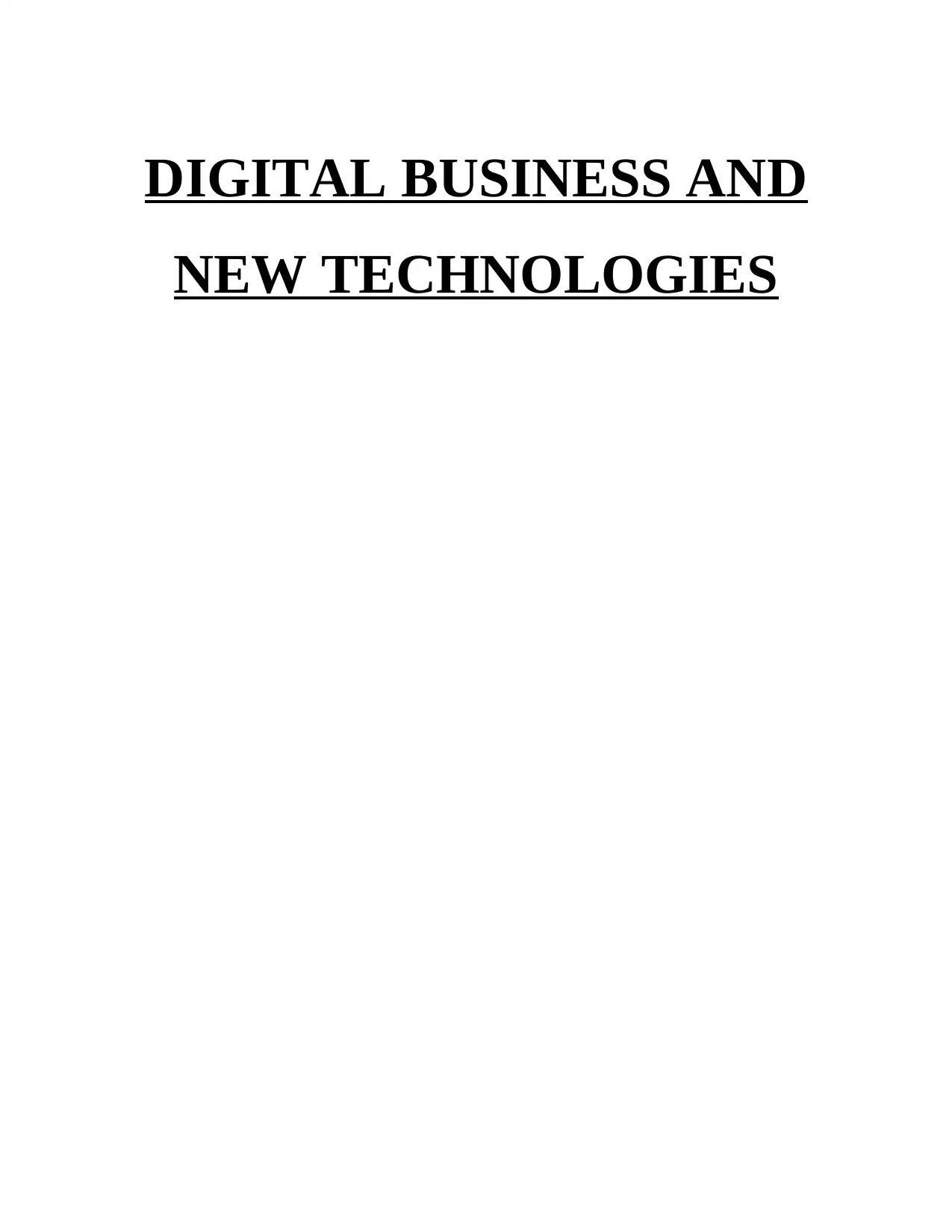
DIGITAL BUSINESS AND
NEW TECHNOLOGIES
NEW TECHNOLOGIES
Paraphrase This Document
Need a fresh take? Get an instant paraphrase of this document with our AI Paraphraser

Table of Contents
INTRODUCTION...........................................................................................................................3
MAIN BODY..................................................................................................................................3
CONCLUSION................................................................................................................................7
REFERENCES................................................................................................................................8
INTRODUCTION...........................................................................................................................3
MAIN BODY..................................................................................................................................3
CONCLUSION................................................................................................................................7
REFERENCES................................................................................................................................8
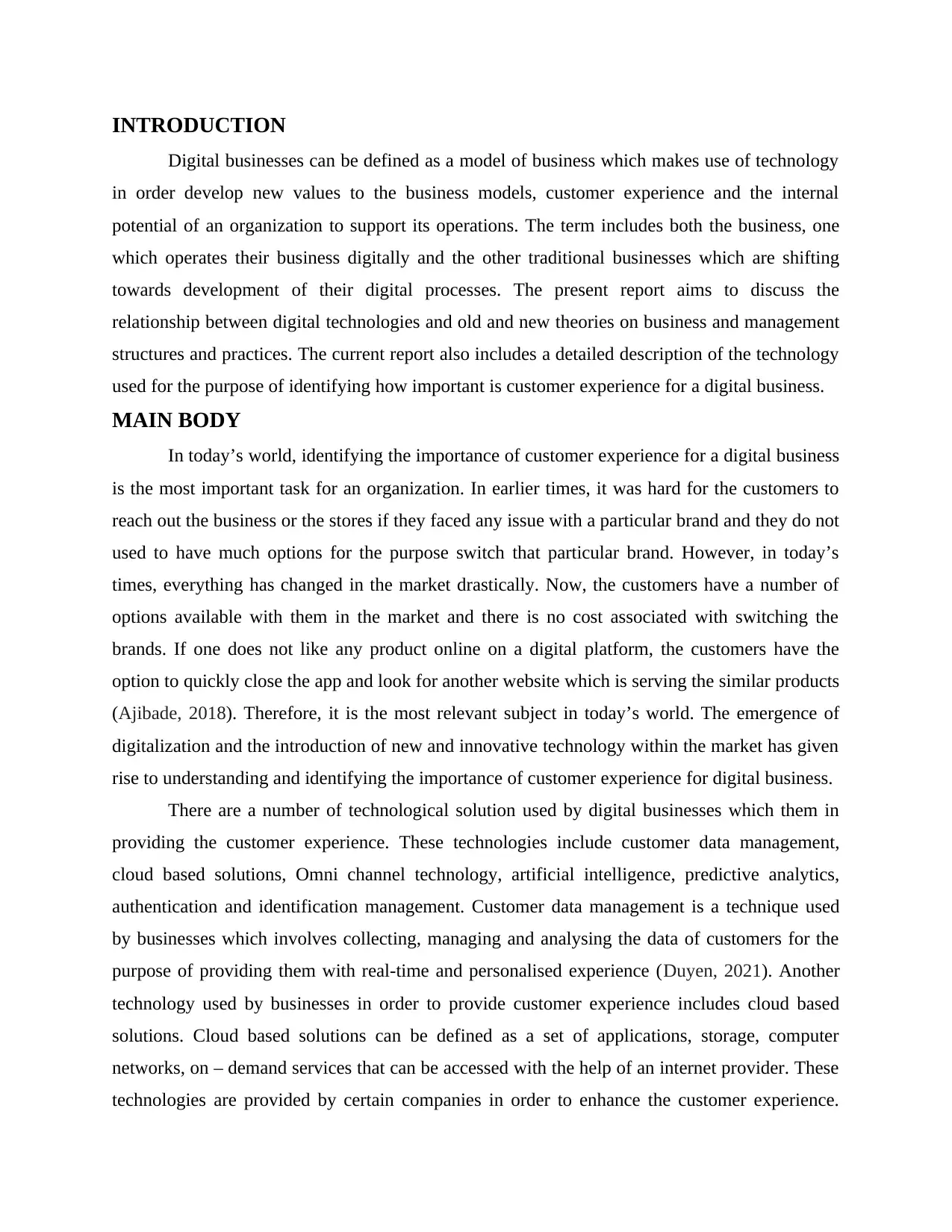
INTRODUCTION
Digital businesses can be defined as a model of business which makes use of technology
in order develop new values to the business models, customer experience and the internal
potential of an organization to support its operations. The term includes both the business, one
which operates their business digitally and the other traditional businesses which are shifting
towards development of their digital processes. The present report aims to discuss the
relationship between digital technologies and old and new theories on business and management
structures and practices. The current report also includes a detailed description of the technology
used for the purpose of identifying how important is customer experience for a digital business.
MAIN BODY
In today’s world, identifying the importance of customer experience for a digital business
is the most important task for an organization. In earlier times, it was hard for the customers to
reach out the business or the stores if they faced any issue with a particular brand and they do not
used to have much options for the purpose switch that particular brand. However, in today’s
times, everything has changed in the market drastically. Now, the customers have a number of
options available with them in the market and there is no cost associated with switching the
brands. If one does not like any product online on a digital platform, the customers have the
option to quickly close the app and look for another website which is serving the similar products
(Ajibade, 2018). Therefore, it is the most relevant subject in today’s world. The emergence of
digitalization and the introduction of new and innovative technology within the market has given
rise to understanding and identifying the importance of customer experience for digital business.
There are a number of technological solution used by digital businesses which them in
providing the customer experience. These technologies include customer data management,
cloud based solutions, Omni channel technology, artificial intelligence, predictive analytics,
authentication and identification management. Customer data management is a technique used
by businesses which involves collecting, managing and analysing the data of customers for the
purpose of providing them with real-time and personalised experience (Duyen, 2021). Another
technology used by businesses in order to provide customer experience includes cloud based
solutions. Cloud based solutions can be defined as a set of applications, storage, computer
networks, on – demand services that can be accessed with the help of an internet provider. These
technologies are provided by certain companies in order to enhance the customer experience.
Digital businesses can be defined as a model of business which makes use of technology
in order develop new values to the business models, customer experience and the internal
potential of an organization to support its operations. The term includes both the business, one
which operates their business digitally and the other traditional businesses which are shifting
towards development of their digital processes. The present report aims to discuss the
relationship between digital technologies and old and new theories on business and management
structures and practices. The current report also includes a detailed description of the technology
used for the purpose of identifying how important is customer experience for a digital business.
MAIN BODY
In today’s world, identifying the importance of customer experience for a digital business
is the most important task for an organization. In earlier times, it was hard for the customers to
reach out the business or the stores if they faced any issue with a particular brand and they do not
used to have much options for the purpose switch that particular brand. However, in today’s
times, everything has changed in the market drastically. Now, the customers have a number of
options available with them in the market and there is no cost associated with switching the
brands. If one does not like any product online on a digital platform, the customers have the
option to quickly close the app and look for another website which is serving the similar products
(Ajibade, 2018). Therefore, it is the most relevant subject in today’s world. The emergence of
digitalization and the introduction of new and innovative technology within the market has given
rise to understanding and identifying the importance of customer experience for digital business.
There are a number of technological solution used by digital businesses which them in
providing the customer experience. These technologies include customer data management,
cloud based solutions, Omni channel technology, artificial intelligence, predictive analytics,
authentication and identification management. Customer data management is a technique used
by businesses which involves collecting, managing and analysing the data of customers for the
purpose of providing them with real-time and personalised experience (Duyen, 2021). Another
technology used by businesses in order to provide customer experience includes cloud based
solutions. Cloud based solutions can be defined as a set of applications, storage, computer
networks, on – demand services that can be accessed with the help of an internet provider. These
technologies are provided by certain companies in order to enhance the customer experience.
⊘ This is a preview!⊘
Do you want full access?
Subscribe today to unlock all pages.

Trusted by 1+ million students worldwide
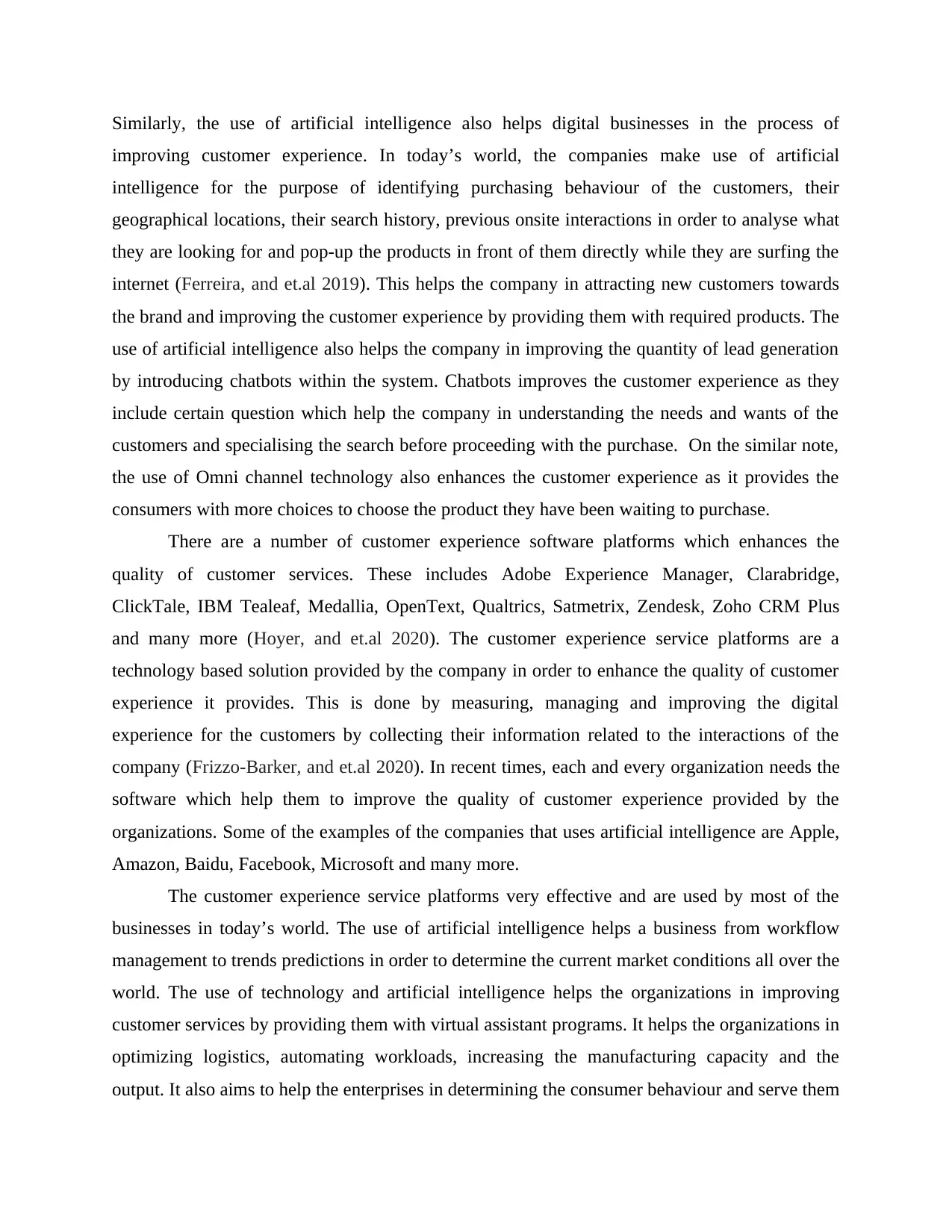
Similarly, the use of artificial intelligence also helps digital businesses in the process of
improving customer experience. In today’s world, the companies make use of artificial
intelligence for the purpose of identifying purchasing behaviour of the customers, their
geographical locations, their search history, previous onsite interactions in order to analyse what
they are looking for and pop-up the products in front of them directly while they are surfing the
internet (Ferreira, and et.al 2019). This helps the company in attracting new customers towards
the brand and improving the customer experience by providing them with required products. The
use of artificial intelligence also helps the company in improving the quantity of lead generation
by introducing chatbots within the system. Chatbots improves the customer experience as they
include certain question which help the company in understanding the needs and wants of the
customers and specialising the search before proceeding with the purchase. On the similar note,
the use of Omni channel technology also enhances the customer experience as it provides the
consumers with more choices to choose the product they have been waiting to purchase.
There are a number of customer experience software platforms which enhances the
quality of customer services. These includes Adobe Experience Manager, Clarabridge,
ClickTale, IBM Tealeaf, Medallia, OpenText, Qualtrics, Satmetrix, Zendesk, Zoho CRM Plus
and many more (Hoyer, and et.al 2020). The customer experience service platforms are a
technology based solution provided by the company in order to enhance the quality of customer
experience it provides. This is done by measuring, managing and improving the digital
experience for the customers by collecting their information related to the interactions of the
company (Frizzo-Barker, and et.al 2020). In recent times, each and every organization needs the
software which help them to improve the quality of customer experience provided by the
organizations. Some of the examples of the companies that uses artificial intelligence are Apple,
Amazon, Baidu, Facebook, Microsoft and many more.
The customer experience service platforms very effective and are used by most of the
businesses in today’s world. The use of artificial intelligence helps a business from workflow
management to trends predictions in order to determine the current market conditions all over the
world. The use of technology and artificial intelligence helps the organizations in improving
customer services by providing them with virtual assistant programs. It helps the organizations in
optimizing logistics, automating workloads, increasing the manufacturing capacity and the
output. It also aims to help the enterprises in determining the consumer behaviour and serve them
improving customer experience. In today’s world, the companies make use of artificial
intelligence for the purpose of identifying purchasing behaviour of the customers, their
geographical locations, their search history, previous onsite interactions in order to analyse what
they are looking for and pop-up the products in front of them directly while they are surfing the
internet (Ferreira, and et.al 2019). This helps the company in attracting new customers towards
the brand and improving the customer experience by providing them with required products. The
use of artificial intelligence also helps the company in improving the quantity of lead generation
by introducing chatbots within the system. Chatbots improves the customer experience as they
include certain question which help the company in understanding the needs and wants of the
customers and specialising the search before proceeding with the purchase. On the similar note,
the use of Omni channel technology also enhances the customer experience as it provides the
consumers with more choices to choose the product they have been waiting to purchase.
There are a number of customer experience software platforms which enhances the
quality of customer services. These includes Adobe Experience Manager, Clarabridge,
ClickTale, IBM Tealeaf, Medallia, OpenText, Qualtrics, Satmetrix, Zendesk, Zoho CRM Plus
and many more (Hoyer, and et.al 2020). The customer experience service platforms are a
technology based solution provided by the company in order to enhance the quality of customer
experience it provides. This is done by measuring, managing and improving the digital
experience for the customers by collecting their information related to the interactions of the
company (Frizzo-Barker, and et.al 2020). In recent times, each and every organization needs the
software which help them to improve the quality of customer experience provided by the
organizations. Some of the examples of the companies that uses artificial intelligence are Apple,
Amazon, Baidu, Facebook, Microsoft and many more.
The customer experience service platforms very effective and are used by most of the
businesses in today’s world. The use of artificial intelligence helps a business from workflow
management to trends predictions in order to determine the current market conditions all over the
world. The use of technology and artificial intelligence helps the organizations in improving
customer services by providing them with virtual assistant programs. It helps the organizations in
optimizing logistics, automating workloads, increasing the manufacturing capacity and the
output. It also aims to help the enterprises in determining the consumer behaviour and serve them
Paraphrase This Document
Need a fresh take? Get an instant paraphrase of this document with our AI Paraphraser
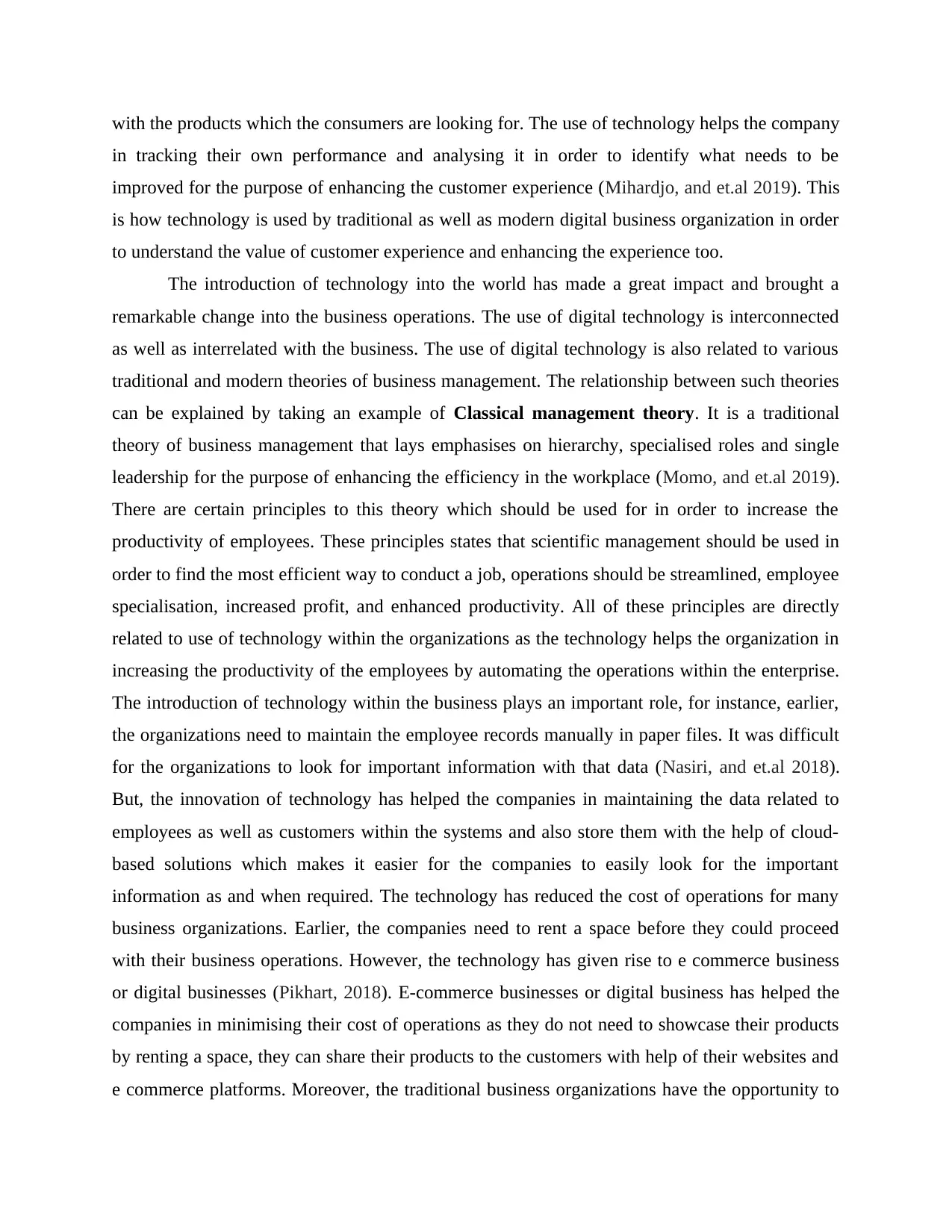
with the products which the consumers are looking for. The use of technology helps the company
in tracking their own performance and analysing it in order to identify what needs to be
improved for the purpose of enhancing the customer experience (Mihardjo, and et.al 2019). This
is how technology is used by traditional as well as modern digital business organization in order
to understand the value of customer experience and enhancing the experience too.
The introduction of technology into the world has made a great impact and brought a
remarkable change into the business operations. The use of digital technology is interconnected
as well as interrelated with the business. The use of digital technology is also related to various
traditional and modern theories of business management. The relationship between such theories
can be explained by taking an example of Classical management theory. It is a traditional
theory of business management that lays emphasises on hierarchy, specialised roles and single
leadership for the purpose of enhancing the efficiency in the workplace (Momo, and et.al 2019).
There are certain principles to this theory which should be used for in order to increase the
productivity of employees. These principles states that scientific management should be used in
order to find the most efficient way to conduct a job, operations should be streamlined, employee
specialisation, increased profit, and enhanced productivity. All of these principles are directly
related to use of technology within the organizations as the technology helps the organization in
increasing the productivity of the employees by automating the operations within the enterprise.
The introduction of technology within the business plays an important role, for instance, earlier,
the organizations need to maintain the employee records manually in paper files. It was difficult
for the organizations to look for important information with that data (Nasiri, and et.al 2018).
But, the innovation of technology has helped the companies in maintaining the data related to
employees as well as customers within the systems and also store them with the help of cloud-
based solutions which makes it easier for the companies to easily look for the important
information as and when required. The technology has reduced the cost of operations for many
business organizations. Earlier, the companies need to rent a space before they could proceed
with their business operations. However, the technology has given rise to e commerce business
or digital businesses (Pikhart, 2018). E-commerce businesses or digital business has helped the
companies in minimising their cost of operations as they do not need to showcase their products
by renting a space, they can share their products to the customers with help of their websites and
e commerce platforms. Moreover, the traditional business organizations have the opportunity to
in tracking their own performance and analysing it in order to identify what needs to be
improved for the purpose of enhancing the customer experience (Mihardjo, and et.al 2019). This
is how technology is used by traditional as well as modern digital business organization in order
to understand the value of customer experience and enhancing the experience too.
The introduction of technology into the world has made a great impact and brought a
remarkable change into the business operations. The use of digital technology is interconnected
as well as interrelated with the business. The use of digital technology is also related to various
traditional and modern theories of business management. The relationship between such theories
can be explained by taking an example of Classical management theory. It is a traditional
theory of business management that lays emphasises on hierarchy, specialised roles and single
leadership for the purpose of enhancing the efficiency in the workplace (Momo, and et.al 2019).
There are certain principles to this theory which should be used for in order to increase the
productivity of employees. These principles states that scientific management should be used in
order to find the most efficient way to conduct a job, operations should be streamlined, employee
specialisation, increased profit, and enhanced productivity. All of these principles are directly
related to use of technology within the organizations as the technology helps the organization in
increasing the productivity of the employees by automating the operations within the enterprise.
The introduction of technology within the business plays an important role, for instance, earlier,
the organizations need to maintain the employee records manually in paper files. It was difficult
for the organizations to look for important information with that data (Nasiri, and et.al 2018).
But, the innovation of technology has helped the companies in maintaining the data related to
employees as well as customers within the systems and also store them with the help of cloud-
based solutions which makes it easier for the companies to easily look for the important
information as and when required. The technology has reduced the cost of operations for many
business organizations. Earlier, the companies need to rent a space before they could proceed
with their business operations. However, the technology has given rise to e commerce business
or digital businesses (Pikhart, 2018). E-commerce businesses or digital business has helped the
companies in minimising their cost of operations as they do not need to showcase their products
by renting a space, they can share their products to the customers with help of their websites and
e commerce platforms. Moreover, the traditional business organizations have the opportunity to
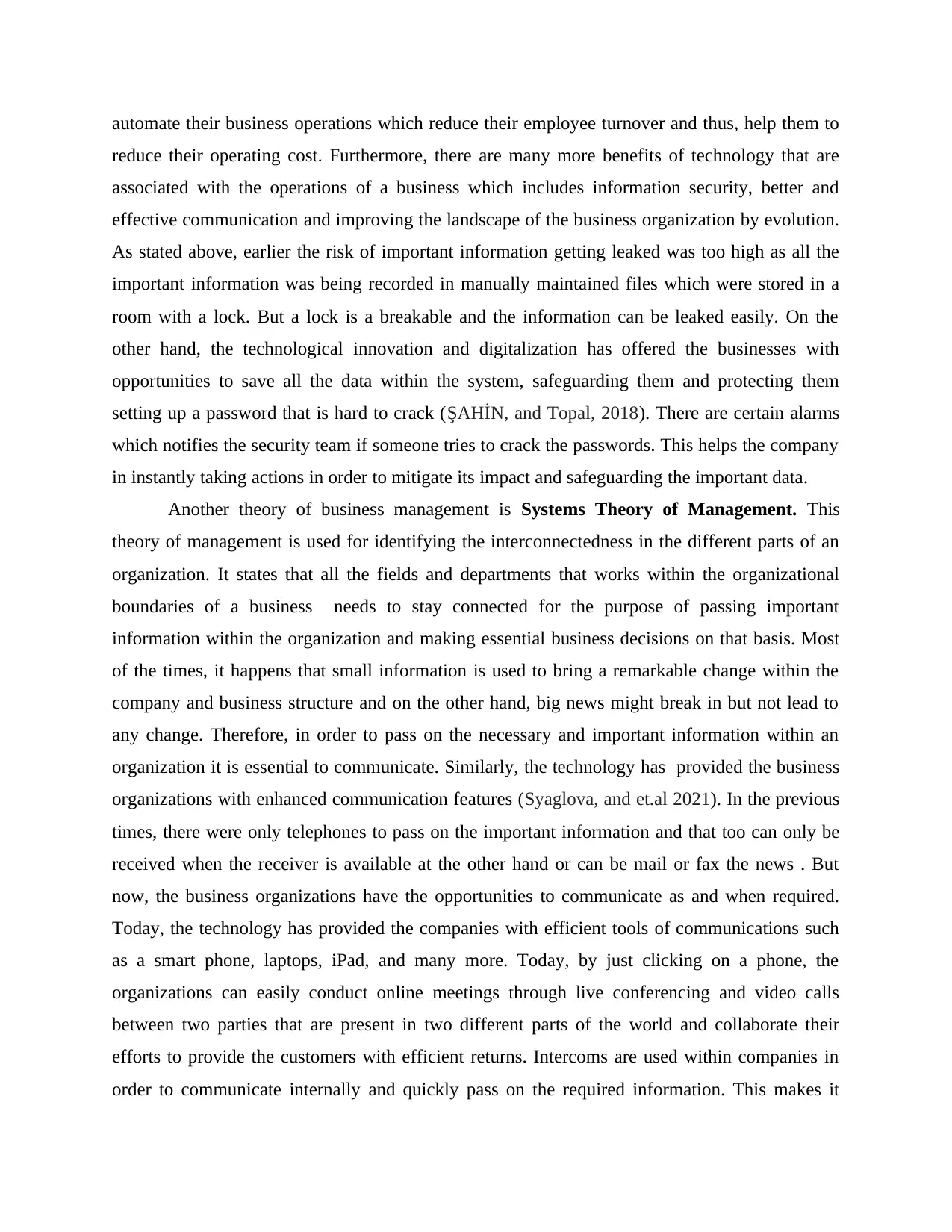
automate their business operations which reduce their employee turnover and thus, help them to
reduce their operating cost. Furthermore, there are many more benefits of technology that are
associated with the operations of a business which includes information security, better and
effective communication and improving the landscape of the business organization by evolution.
As stated above, earlier the risk of important information getting leaked was too high as all the
important information was being recorded in manually maintained files which were stored in a
room with a lock. But a lock is a breakable and the information can be leaked easily. On the
other hand, the technological innovation and digitalization has offered the businesses with
opportunities to save all the data within the system, safeguarding them and protecting them
setting up a password that is hard to crack (ŞAHİN, and Topal, 2018). There are certain alarms
which notifies the security team if someone tries to crack the passwords. This helps the company
in instantly taking actions in order to mitigate its impact and safeguarding the important data.
Another theory of business management is Systems Theory of Management. This
theory of management is used for identifying the interconnectedness in the different parts of an
organization. It states that all the fields and departments that works within the organizational
boundaries of a business needs to stay connected for the purpose of passing important
information within the organization and making essential business decisions on that basis. Most
of the times, it happens that small information is used to bring a remarkable change within the
company and business structure and on the other hand, big news might break in but not lead to
any change. Therefore, in order to pass on the necessary and important information within an
organization it is essential to communicate. Similarly, the technology has provided the business
organizations with enhanced communication features (Syaglova, and et.al 2021). In the previous
times, there were only telephones to pass on the important information and that too can only be
received when the receiver is available at the other hand or can be mail or fax the news . But
now, the business organizations have the opportunities to communicate as and when required.
Today, the technology has provided the companies with efficient tools of communications such
as a smart phone, laptops, iPad, and many more. Today, by just clicking on a phone, the
organizations can easily conduct online meetings through live conferencing and video calls
between two parties that are present in two different parts of the world and collaborate their
efforts to provide the customers with efficient returns. Intercoms are used within companies in
order to communicate internally and quickly pass on the required information. This makes it
reduce their operating cost. Furthermore, there are many more benefits of technology that are
associated with the operations of a business which includes information security, better and
effective communication and improving the landscape of the business organization by evolution.
As stated above, earlier the risk of important information getting leaked was too high as all the
important information was being recorded in manually maintained files which were stored in a
room with a lock. But a lock is a breakable and the information can be leaked easily. On the
other hand, the technological innovation and digitalization has offered the businesses with
opportunities to save all the data within the system, safeguarding them and protecting them
setting up a password that is hard to crack (ŞAHİN, and Topal, 2018). There are certain alarms
which notifies the security team if someone tries to crack the passwords. This helps the company
in instantly taking actions in order to mitigate its impact and safeguarding the important data.
Another theory of business management is Systems Theory of Management. This
theory of management is used for identifying the interconnectedness in the different parts of an
organization. It states that all the fields and departments that works within the organizational
boundaries of a business needs to stay connected for the purpose of passing important
information within the organization and making essential business decisions on that basis. Most
of the times, it happens that small information is used to bring a remarkable change within the
company and business structure and on the other hand, big news might break in but not lead to
any change. Therefore, in order to pass on the necessary and important information within an
organization it is essential to communicate. Similarly, the technology has provided the business
organizations with enhanced communication features (Syaglova, and et.al 2021). In the previous
times, there were only telephones to pass on the important information and that too can only be
received when the receiver is available at the other hand or can be mail or fax the news . But
now, the business organizations have the opportunities to communicate as and when required.
Today, the technology has provided the companies with efficient tools of communications such
as a smart phone, laptops, iPad, and many more. Today, by just clicking on a phone, the
organizations can easily conduct online meetings through live conferencing and video calls
between two parties that are present in two different parts of the world and collaborate their
efforts to provide the customers with efficient returns. Intercoms are used within companies in
order to communicate internally and quickly pass on the required information. This makes it
⊘ This is a preview!⊘
Do you want full access?
Subscribe today to unlock all pages.

Trusted by 1+ million students worldwide
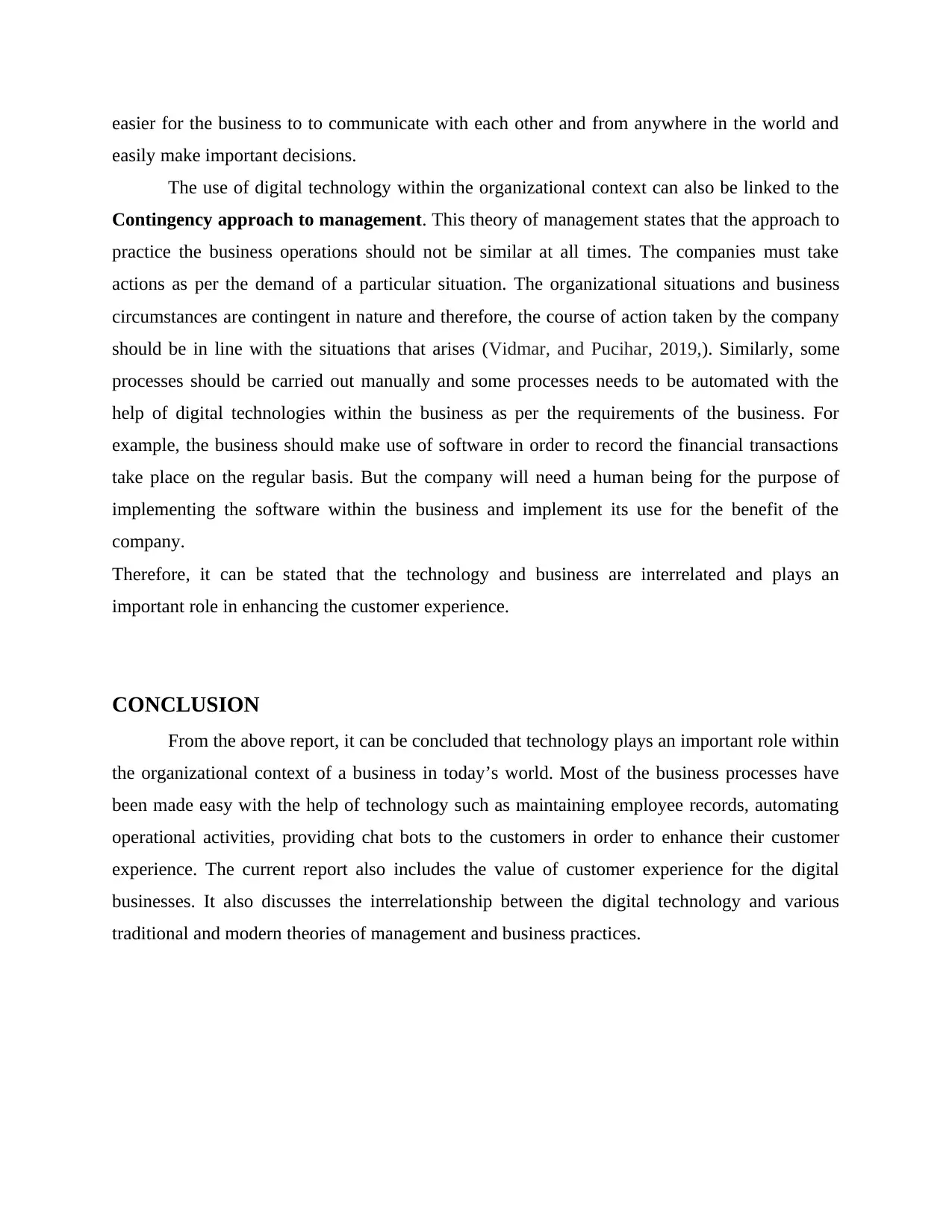
easier for the business to to communicate with each other and from anywhere in the world and
easily make important decisions.
The use of digital technology within the organizational context can also be linked to the
Contingency approach to management. This theory of management states that the approach to
practice the business operations should not be similar at all times. The companies must take
actions as per the demand of a particular situation. The organizational situations and business
circumstances are contingent in nature and therefore, the course of action taken by the company
should be in line with the situations that arises (Vidmar, and Pucihar, 2019,). Similarly, some
processes should be carried out manually and some processes needs to be automated with the
help of digital technologies within the business as per the requirements of the business. For
example, the business should make use of software in order to record the financial transactions
take place on the regular basis. But the company will need a human being for the purpose of
implementing the software within the business and implement its use for the benefit of the
company.
Therefore, it can be stated that the technology and business are interrelated and plays an
important role in enhancing the customer experience.
CONCLUSION
From the above report, it can be concluded that technology plays an important role within
the organizational context of a business in today’s world. Most of the business processes have
been made easy with the help of technology such as maintaining employee records, automating
operational activities, providing chat bots to the customers in order to enhance their customer
experience. The current report also includes the value of customer experience for the digital
businesses. It also discusses the interrelationship between the digital technology and various
traditional and modern theories of management and business practices.
easily make important decisions.
The use of digital technology within the organizational context can also be linked to the
Contingency approach to management. This theory of management states that the approach to
practice the business operations should not be similar at all times. The companies must take
actions as per the demand of a particular situation. The organizational situations and business
circumstances are contingent in nature and therefore, the course of action taken by the company
should be in line with the situations that arises (Vidmar, and Pucihar, 2019,). Similarly, some
processes should be carried out manually and some processes needs to be automated with the
help of digital technologies within the business as per the requirements of the business. For
example, the business should make use of software in order to record the financial transactions
take place on the regular basis. But the company will need a human being for the purpose of
implementing the software within the business and implement its use for the benefit of the
company.
Therefore, it can be stated that the technology and business are interrelated and plays an
important role in enhancing the customer experience.
CONCLUSION
From the above report, it can be concluded that technology plays an important role within
the organizational context of a business in today’s world. Most of the business processes have
been made easy with the help of technology such as maintaining employee records, automating
operational activities, providing chat bots to the customers in order to enhance their customer
experience. The current report also includes the value of customer experience for the digital
businesses. It also discusses the interrelationship between the digital technology and various
traditional and modern theories of management and business practices.
Paraphrase This Document
Need a fresh take? Get an instant paraphrase of this document with our AI Paraphraser
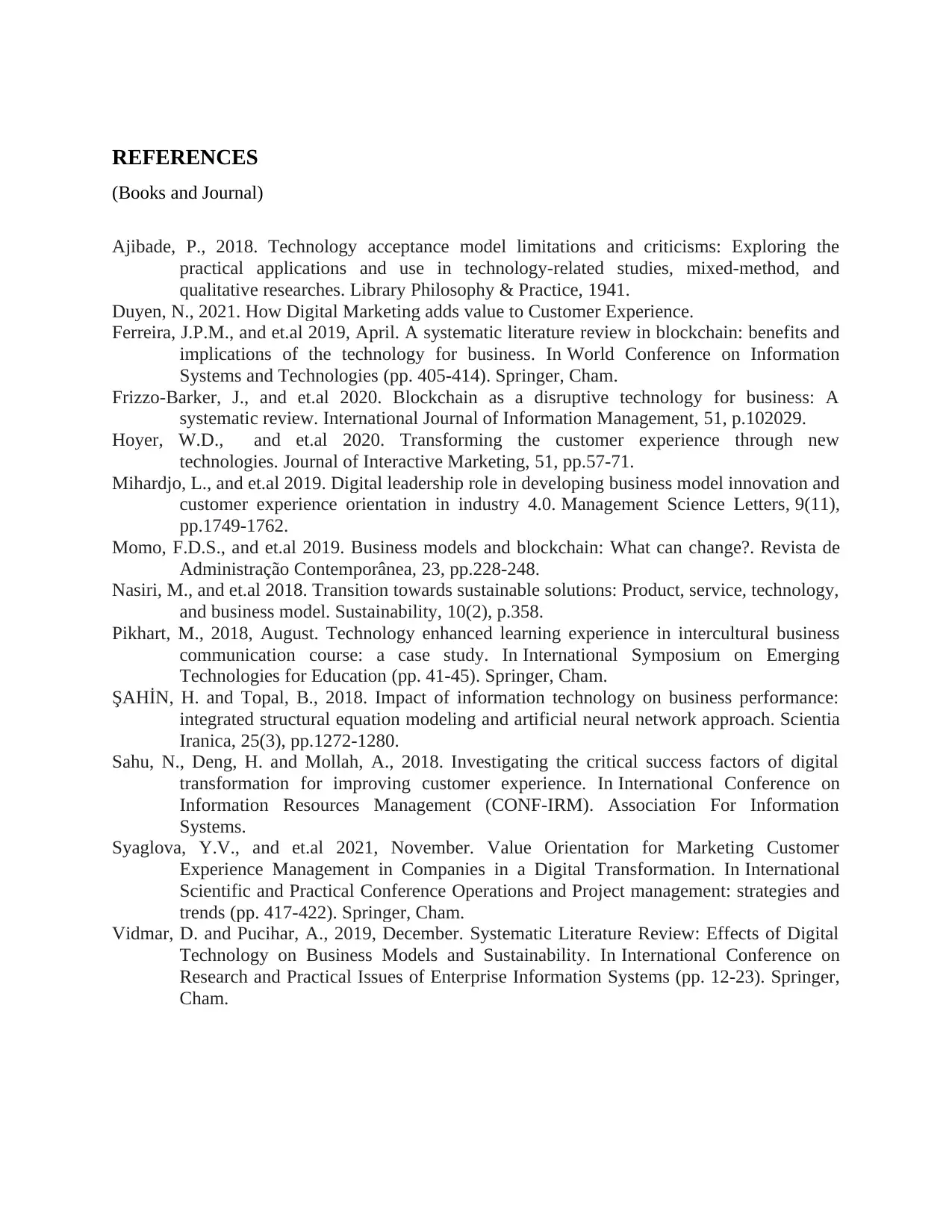
REFERENCES
(Books and Journal)
Ajibade, P., 2018. Technology acceptance model limitations and criticisms: Exploring the
practical applications and use in technology-related studies, mixed-method, and
qualitative researches. Library Philosophy & Practice, 1941.
Duyen, N., 2021. How Digital Marketing adds value to Customer Experience.
Ferreira, J.P.M., and et.al 2019, April. A systematic literature review in blockchain: benefits and
implications of the technology for business. In World Conference on Information
Systems and Technologies (pp. 405-414). Springer, Cham.
Frizzo-Barker, J., and et.al 2020. Blockchain as a disruptive technology for business: A
systematic review. International Journal of Information Management, 51, p.102029.
Hoyer, W.D., and et.al 2020. Transforming the customer experience through new
technologies. Journal of Interactive Marketing, 51, pp.57-71.
Mihardjo, L., and et.al 2019. Digital leadership role in developing business model innovation and
customer experience orientation in industry 4.0. Management Science Letters, 9(11),
pp.1749-1762.
Momo, F.D.S., and et.al 2019. Business models and blockchain: What can change?. Revista de
Administração Contemporânea, 23, pp.228-248.
Nasiri, M., and et.al 2018. Transition towards sustainable solutions: Product, service, technology,
and business model. Sustainability, 10(2), p.358.
Pikhart, M., 2018, August. Technology enhanced learning experience in intercultural business
communication course: a case study. In International Symposium on Emerging
Technologies for Education (pp. 41-45). Springer, Cham.
ŞAHİN, H. and Topal, B., 2018. Impact of information technology on business performance:
integrated structural equation modeling and artificial neural network approach. Scientia
Iranica, 25(3), pp.1272-1280.
Sahu, N., Deng, H. and Mollah, A., 2018. Investigating the critical success factors of digital
transformation for improving customer experience. In International Conference on
Information Resources Management (CONF-IRM). Association For Information
Systems.
Syaglova, Y.V., and et.al 2021, November. Value Orientation for Marketing Customer
Experience Management in Companies in a Digital Transformation. In International
Scientific and Practical Conference Operations and Project management: strategies and
trends (pp. 417-422). Springer, Cham.
Vidmar, D. and Pucihar, A., 2019, December. Systematic Literature Review: Effects of Digital
Technology on Business Models and Sustainability. In International Conference on
Research and Practical Issues of Enterprise Information Systems (pp. 12-23). Springer,
Cham.
(Books and Journal)
Ajibade, P., 2018. Technology acceptance model limitations and criticisms: Exploring the
practical applications and use in technology-related studies, mixed-method, and
qualitative researches. Library Philosophy & Practice, 1941.
Duyen, N., 2021. How Digital Marketing adds value to Customer Experience.
Ferreira, J.P.M., and et.al 2019, April. A systematic literature review in blockchain: benefits and
implications of the technology for business. In World Conference on Information
Systems and Technologies (pp. 405-414). Springer, Cham.
Frizzo-Barker, J., and et.al 2020. Blockchain as a disruptive technology for business: A
systematic review. International Journal of Information Management, 51, p.102029.
Hoyer, W.D., and et.al 2020. Transforming the customer experience through new
technologies. Journal of Interactive Marketing, 51, pp.57-71.
Mihardjo, L., and et.al 2019. Digital leadership role in developing business model innovation and
customer experience orientation in industry 4.0. Management Science Letters, 9(11),
pp.1749-1762.
Momo, F.D.S., and et.al 2019. Business models and blockchain: What can change?. Revista de
Administração Contemporânea, 23, pp.228-248.
Nasiri, M., and et.al 2018. Transition towards sustainable solutions: Product, service, technology,
and business model. Sustainability, 10(2), p.358.
Pikhart, M., 2018, August. Technology enhanced learning experience in intercultural business
communication course: a case study. In International Symposium on Emerging
Technologies for Education (pp. 41-45). Springer, Cham.
ŞAHİN, H. and Topal, B., 2018. Impact of information technology on business performance:
integrated structural equation modeling and artificial neural network approach. Scientia
Iranica, 25(3), pp.1272-1280.
Sahu, N., Deng, H. and Mollah, A., 2018. Investigating the critical success factors of digital
transformation for improving customer experience. In International Conference on
Information Resources Management (CONF-IRM). Association For Information
Systems.
Syaglova, Y.V., and et.al 2021, November. Value Orientation for Marketing Customer
Experience Management in Companies in a Digital Transformation. In International
Scientific and Practical Conference Operations and Project management: strategies and
trends (pp. 417-422). Springer, Cham.
Vidmar, D. and Pucihar, A., 2019, December. Systematic Literature Review: Effects of Digital
Technology on Business Models and Sustainability. In International Conference on
Research and Practical Issues of Enterprise Information Systems (pp. 12-23). Springer,
Cham.

⊘ This is a preview!⊘
Do you want full access?
Subscribe today to unlock all pages.

Trusted by 1+ million students worldwide
1 out of 9
Related Documents
Your All-in-One AI-Powered Toolkit for Academic Success.
+13062052269
info@desklib.com
Available 24*7 on WhatsApp / Email
![[object Object]](/_next/static/media/star-bottom.7253800d.svg)
Unlock your academic potential
Copyright © 2020–2025 A2Z Services. All Rights Reserved. Developed and managed by ZUCOL.





